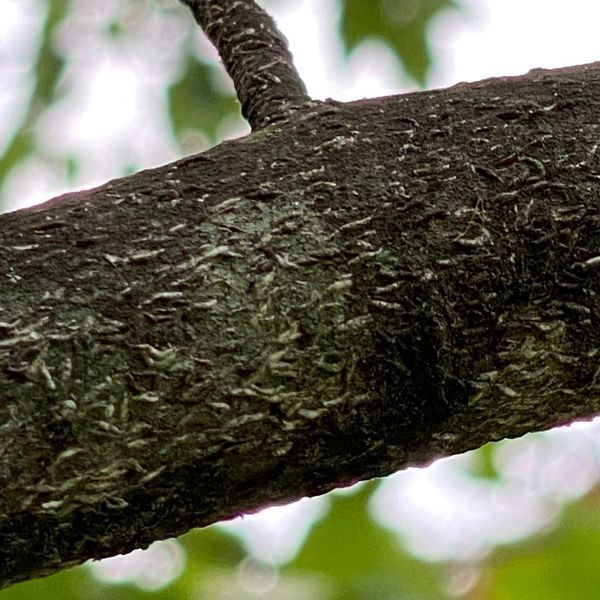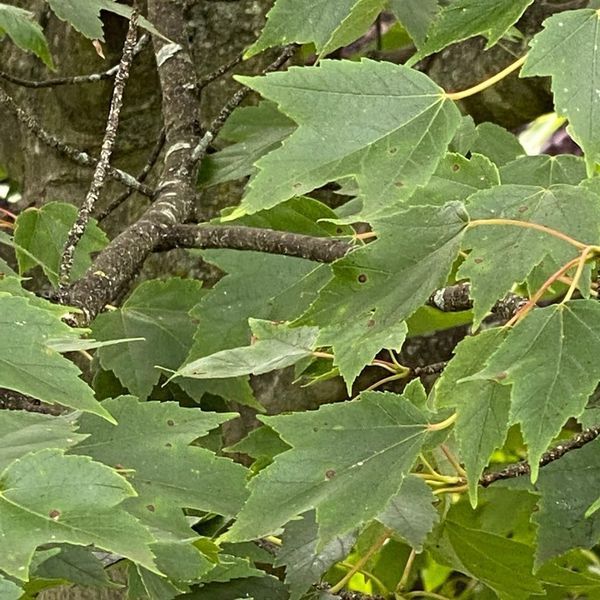Protect Your Trees from Japanese Maple Scale
Japanese Maple Scale (Lopholeucaspis japonica) is a formidable pest that poses a significant challenge to homeowners. Belonging to the family Diaspididae, the Japanese Maple Scale has spread throughout the United States, infesting many host trees and causing substantial damage if left untreated. This pest requires vigilance and proactive management. By understanding the life cycle and having plant health care professionals implement effective control measures, homeowners can mitigate the damage caused by this persistent insect pest.
Appearance
The mature female covers of the Japanese Maple Scale are oyster shell-shaped, measuring less than ⅛” (3 mm) in length. Adult females are purple, but covered by a dark brown shed exoskeleton with a thin white coating. The male covers of this insect are similar in appearance but smaller in size and have a slightly more elongated shape.
One of the key features to look out for when identifying the Japanese Maple Scale is the color of the young scales, or crawlers. These tiny young scales are purple and can be found in the bark cracks of infested trees, as the scales can often be wedged into these crevices.
Life Cycle
The life cycle of the Japanese Maple Scale consists of three distinct stages: egg, immature, and adult. Understanding this life cycle is necessary for effectively managing scale populations and preventing damage to host trees.
The life cycle begins with the tiny eggs laid by adult female scales. These eggs are typically deposited beneath the protective waxy cover and are difficult to spot without close inspection. After incubation, the eggs hatch, releasing the immature nymphs known as crawlers.

These crawlers are the mobile stage of the scale and can quickly spread to other parts of infested trees or adjacent healthy plants. As the crawlers feed on plant sap, they go through several molting stages called instars, gradually growing larger and developing a protective shell-like covering, known as a “test.”
Once the final instar is reached, the immature nymphs transition into the adult stage, where the cycle repeats.
Japanese Maple Scale Tree Damage
Japanese Maple Scale can wreak havoc on trees, causing significant damage and leading to a gradual decline in their health. These troublesome insects feed on the sap of trees, robbing them of essential nutrients and energy. As a result, the affected trees often experience twig and branch dieback, making the foliage sparse and thin.
The damage caused by the Japanese Maple Scale manifests as a bumpy white texture on the branches of heavily infested trees. The scales create this white, waxy covering during feeding and reproduction. The presence of this distinctive texture is a clear indicator of a scale infestation.
Over time the affected tree may lose vigor and become more susceptible to other stresses and diseases. Thinning foliage, early leaf drop, and twig and branch dieback are often observed as the scale populations increase and spread throughout the tree.
Host Plants
Japanese Maple Scale is known to attack a wide range of host plants. Some of the most commonly affected ones include dogwoods, elms, maples, magnolias, and lilacs. These plants, belonging to various plant families, are highly susceptible to infestations by the Japanese Maple Scale.

Management
Effective integrated pest management of the Japanese maple scale is crucial for the health and vitality of infested trees. Controlling the Japanese Maple Scale can be challenging due to the quick development of their waxy coating.
Armored scales, like the Japanese Maple Scale, are named for the hard, waxy cover that protects the insect. This armor can prevent some traditional contact insecticides from penetrating and effectively controlling the scale populations. However, several treatment options can help manage this insect pest.
For light infestations, pruning out infested branches can be effective.
In cases of heavy infestations, removal could be necessary to prevent spreading to healthy trees. However, some treatment methods can manage scale infestations.
Insecticides
Systemic insecticides absorbed by the plant’s vascular system can provide long-term control by targeting the scales at various life cycle stages. This treatment option can be applied as a foliar spray to coat the leaves or as a bark spray to protect the plant from the inside out.
Horticultural oil is a treatment practice that works by suffocating the scales and is most effective during the crawler stage when the waxy coating is still developing. The oil must be applied thoroughly, covering both the tops and undersides of the leaves and the branches of the infested trees. Horticultural oil applications can also work when applied in late fall because the oil dissolves the waxy coating and exposes the scale to cold weather conditions.
Biological control methods, such as parasitoid wasps and other natural enemies, can also be employed. These beneficial insects prey on scales, helping to keep their populations in check.
Preventive Methods of Controlling Japanese Maple Scale
Implementing proper cultural practices can help reduce the risk of scale infestation. Good irrigation and mulching techniques promote the overall health of the plants, making them more resistant to infestations. Consistent watering and mulching can also prevent stress and minimize the risk of scale outbreaks.
Inspecting new plant material before introducing plants to a garden is crucial in preventing the spread of the Japanese Maple Scale. By carefully examining new plants for signs of infestation, such as adult scales or crawler activity, you can avoid introducing scale-infested plants to your garden.
Contact Burkholder PHC for Japanese Maple Scale Treatment in Your Landscape
If you are concerned about the presence of the Japanese Maple Scale on your property, contact Burkholder PHC for expert advice and treatment options. Our team of highly experienced, qualified plant health care experts provides a free evaluation of your landscape to help remove and control invasive species and their adverse effects. Contact Burkholder PHC today for a free consultation.

